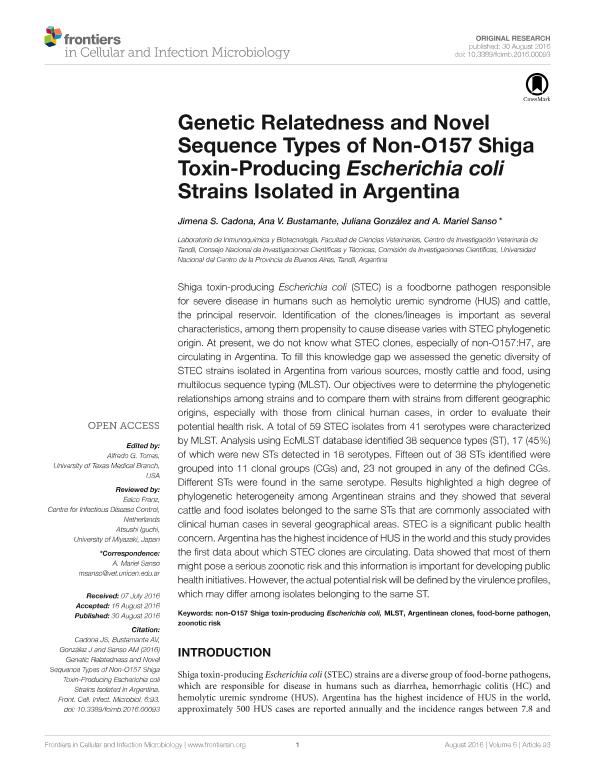Mostrar el registro sencillo del ítem
dc.contributor.author
Cadona, Jimena Soledad

dc.contributor.author
Bustamante, Ana Victoria

dc.contributor.author
González, Juliana

dc.contributor.author
Sanso, Andrea Mariel

dc.date.available
2018-09-06T14:54:58Z
dc.date.issued
2016-08
dc.identifier.citation
Cadona, Jimena Soledad; Bustamante, Ana Victoria; González, Juliana; Sanso, Andrea Mariel; Genetic relatedness and novel sequence types of non-O157 Shiga toxin-producing Escherichia coli Strains Isolated in Argentina; Frontiers Research Foundation; Frontiers in Cellular and Infection Microbiology; 6; AUG; 8-2016; 1-7
dc.identifier.issn
2235-2988
dc.identifier.uri
http://hdl.handle.net/11336/58505
dc.description.abstract
Shiga toxin-producing Escherichia coli (STEC) is a foodborne pathogen responsible for severe disease in humans such as hemolytic uremic syndrome (HUS) and cattle, the principal reservoir. Identification of the clones/lineages is important as several characteristics, among them propensity to cause disease varies with STEC phylogenetic origin. At present, we do not know what STEC clones, especially of non-O157:H7, are circulating in Argentina. To fill this knowledge gap we assessed the genetic diversity of STEC strains isolated in Argentina from various sources, mostly cattle and food, using multilocus sequence typing (MLST). Our objectives were to determine the phylogenetic relationships among strains and to compare them with strains from different geographic origins, especially with those from clinical human cases, in order to evaluate their potential health risk. A total of 59 STEC isolates from 41 serotypes were characterized by MLST. Analysis using EcMLST database identified 38 sequence types (ST), 17 (45%) of which were new STs detected in 18 serotypes. Fifteen out of 38 STs identified were grouped into 11 clonal groups (CGs) and, 23 not grouped in any of the defined CGs. Different STs were found in the same serotype. Results highlighted a high degree of phylogenetic heterogeneity among Argentinean strains and they showed that several cattle and food isolates belonged to the same STs that are commonly associated with clinical human cases in several geographical areas. STEC is a significant public health concern. Argentina has the highest incidence of HUS in the world and this study provides the first data about which STEC clones are circulating. Data showed that most of them might pose a serious zoonotic risk and this information is important for developing public health initiatives. However, the actual potential risk will be defined by the virulence profiles, which may differ among isolates belonging to the same ST.
dc.format
application/pdf
dc.language.iso
eng
dc.publisher
Frontiers Research Foundation

dc.rights
info:eu-repo/semantics/openAccess
dc.rights.uri
https://creativecommons.org/licenses/by-nc-sa/2.5/ar/
dc.subject
Argentinean Clones
dc.subject
Food-Borne Pathogen
dc.subject
Mlst
dc.subject
Non-O157 Shiga Toxin-Producing Escherichia Coli
dc.subject
Zoonotic Risk
dc.subject.classification
Otras Ciencias Biológicas

dc.subject.classification
Ciencias Biológicas

dc.subject.classification
CIENCIAS NATURALES Y EXACTAS

dc.title
Genetic relatedness and novel sequence types of non-O157 Shiga toxin-producing Escherichia coli Strains Isolated in Argentina
dc.type
info:eu-repo/semantics/article
dc.type
info:ar-repo/semantics/artículo
dc.type
info:eu-repo/semantics/publishedVersion
dc.date.updated
2018-09-05T15:53:58Z
dc.journal.volume
6
dc.journal.number
AUG
dc.journal.pagination
1-7
dc.journal.pais
Suiza

dc.description.fil
Fil: Cadona, Jimena Soledad. Consejo Nacional de Investigaciones Científicas y Técnicas. Centro Científico Tecnológico Conicet - Tandil. Centro de Investigación Veterinaria de Tandil. Universidad Nacional del Centro de la Provincia de Buenos Aires. Centro de Investigación Veterinaria de Tandil. Provincia de Buenos Aires. Gobernación. Comision de Investigaciones Científicas. Centro de Investigación Veterinaria de Tandil; Argentina
dc.description.fil
Fil: Bustamante, Ana Victoria. Consejo Nacional de Investigaciones Científicas y Técnicas. Centro Científico Tecnológico Conicet - Tandil. Centro de Investigación Veterinaria de Tandil. Universidad Nacional del Centro de la Provincia de Buenos Aires. Centro de Investigación Veterinaria de Tandil. Provincia de Buenos Aires. Gobernación. Comision de Investigaciones Científicas. Centro de Investigación Veterinaria de Tandil; Argentina
dc.description.fil
Fil: González, Juliana. Consejo Nacional de Investigaciones Científicas y Técnicas. Centro Científico Tecnológico Conicet - Tandil. Centro de Investigación Veterinaria de Tandil. Universidad Nacional del Centro de la Provincia de Buenos Aires. Centro de Investigación Veterinaria de Tandil. Provincia de Buenos Aires. Gobernación. Comision de Investigaciones Científicas. Centro de Investigación Veterinaria de Tandil; Argentina
dc.description.fil
Fil: Sanso, Andrea Mariel. Consejo Nacional de Investigaciones Científicas y Técnicas. Centro Científico Tecnológico Conicet - Tandil. Centro de Investigación Veterinaria de Tandil. Universidad Nacional del Centro de la Provincia de Buenos Aires. Centro de Investigación Veterinaria de Tandil. Provincia de Buenos Aires. Gobernación. Comision de Investigaciones Científicas. Centro de Investigación Veterinaria de Tandil; Argentina
dc.journal.title
Frontiers in Cellular and Infection Microbiology
dc.relation.alternativeid
info:eu-repo/semantics/altIdentifier/url/https://www.ncbi.nlm.nih.gov/pmc/articles/PMC5003923/
dc.relation.alternativeid
info:eu-repo/semantics/altIdentifier/doi/http://dx.doi.org/10.3389/fcimb.2016.00093
dc.relation.alternativeid
info:eu-repo/semantics/altIdentifier/url/https://www.frontiersin.org/articles/10.3389/fcimb.2016.00093/full
Archivos asociados
